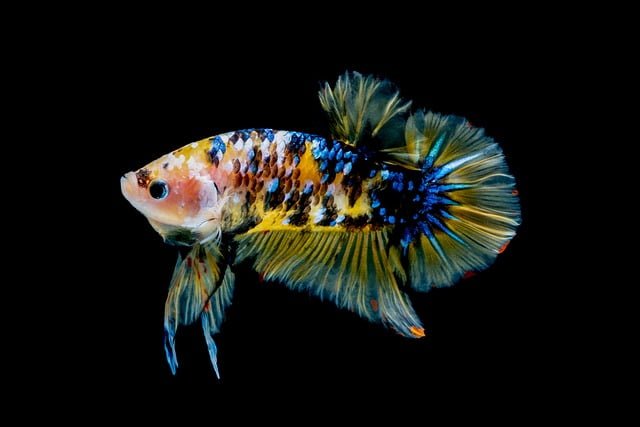Betta fish diseases can pose various health challenges for these vibrant and beautiful aquarium inhabitants, requiring careful attention to their well-being and appropriate treatment measures
1. Fin Rot in Betta fish
Fin rot, also referred to as tail rot, is a prevalent bacterial infection primarily affecting the fins of betta fish. The condition can be mild, causing minimal fin degradation, or severe, leading to significant tissue damage and potential systemic infections.
Symptoms:
- Fraying or disintegration of fins.
- Reddening or inflammation at the fin’s base.
- Sluggish behavior and decreased activity.
Causes:
- Poor water quality, including elevated ammonia and nitrite levels.
- Physical injuries or fin nipping from tank mates.
- Stressors such as abrupt environmental changes or aggressive tank mates.
Treatment:
- Conduct partial water changes to improve water quality.
- Administer broad-spectrum antibiotics like nitrofurazone or kanamycin.
- Ensure a stress-free environment with adequate hiding spots and compatible tank mates.
2. Ich (White Spot Disease) in Betta fish
Ich, or Ichthyophthirius multifiliis, is a highly contagious protozoan parasite causing white cysts or spots on the fish’s body, gills, and fins.
Symptoms:
- White spots resembling grains of salt or sugar.
- Increased scratching or rubbing against objects.
- Respiratory distress in severe cases.
Causes:
- Poor water quality and stress weaken the fish’s immune system, making them susceptible to infections.
- Introduction of infected fish or contaminated equipment.
Treatment:
- Elevate the water temperature to accelerate the parasite’s life cycle and sensitivity to medications (82-85°F or 27-29°C).
- Use medications containing copper sulfate, formalin, or malachite green.
- Quarantine infected fish to prevent spreading and maintain strict hygiene protocols.
3. Velvet Disease in Betta fish
Velvet, caused by the dinoflagellate Piscinoodinium pillulare, presents as a yellowish or gold dust-like appearance on the fish’s skin and fins.
Symptoms:
- Golden or rust-colored dust-like spots.
- Lethargy, rapid breathing, and loss of appetite.
- A visible golden or brown sheen on the skin under light.
Causes:
- Poor water conditions, especially fluctuating pH levels.
- Introduction of infected fish or contaminated plants.
Treatment:
- Increase the water temperature to 80-82°F (27°C).
- Use medications containing copper sulfate or formalin.
- Quarantine and treat infected fish separately to prevent disease spread.
4. Dropsy in Betta fish
Dropsy, or “pinecone disease,” is a symptom rather than a specific disease, characterized by fluid accumulation and organ failure, often linked to bacterial infections.
Symptoms:
- Swollen, bloated abdomen.
- Raised scales resembling a pinecone.
- Lethargy, loss of appetite, and difficulty swimming.
Causes:
- Bacterial infections, especially gram-negative bacteria like Aeromonas or Pseudomonas.
- Poor water quality, stress, or underlying health issues.
Treatment:
- Isolate affected fish to prevent potential disease spread.
- Administer antibiotics such as kanamycin, tetracycline, or erythromycin.
- Improve water quality, ensure optimal tank conditions, and provide supportive care.
5. Columnaris (Mouth Fungus) in Betta fish
Columnaris, caused by the bacterium Flavobacterium columnare, is a severe bacterial infection affecting the skin, fins, and mouth of betta fish.
Symptoms:
- Whitish or grayish patches on the mouth, fins, or body.
- Lethargy, loss of appetite, and respiratory distress in advanced stages.
Causes:
- Poor water quality, especially in overcrowded or unfiltered tanks.
- Stress, physical injuries, or introduction of infected fish.
Treatment:
- Implement antibiotics like kanamycin, tetracycline, or sulfonamides.
- Maintain pristine water conditions, optimize filtration, and ensure adequate aeration.
- Quarantine affected fish and disinfect tank equipment to prevent recurrence.
6. Swim Bladder Disorder in in Betta fish
Swim bladder disorder affects the fish’s buoyancy, causing them to swim erratically or struggle to maintain an upright position.
Symptoms:
- Fish may float upside down, sink to the bottom, or exhibit an abnormal swimming pattern.
- Loss of balance and difficulty navigating the tank.
Causes:
- Overfeeding leading to constipation.
- Physical injuries, tumors, or congenital deformities.
- Bacterial infections or poor water quality.
Treatment:
- Adjust the diet to include fiber-rich foods or fasting for a few days.
- Consider an Epsom salt bath to alleviate symptoms.
- Ensure optimal water conditions and monitor fish behavior closely.
7. Parasitic Infections in Betta fish
Betta fish can fall prey to various external and internal parasites, causing a myriad of symptoms and health complications.
Symptoms:
- Visible worms, flukes, or external parasites.
- Skin irritations, discolorations, or lesions.
- Behavioral changes, including decreased activity, loss of appetite, or abnormal swimming patterns.
Causes:
- Introduction of infected fish, plants, or contaminated water.
- Poor tank hygiene, overpopulation, or stressful conditions.
Treatment:
- Identify the specific parasite through microscopic examination or diagnostic tests.
- Administer targeted antiparasitic medications, such as praziquantel, metronidazole, or fenbendazole.
- Implement strict quarantine protocols and maintain rigorous hygiene practices.
Betta Fish Diseases Prevention
Ensuring the health and well-being of betta fish requires a proactive approach to disease prevention. Regular water quality assessments, adherence to proper feeding practices, minimizing stressors, and maintaining optimal tank conditions are paramount.
When introducing new fish or plants, quarantine them to prevent potential disease transmission. Observing fish behavior, monitoring for any signs of distress, and seeking timely veterinary care can significantly mitigate disease risks.
In conclusion, betta fish are enchanting creatures deserving of attentive care and respect. By understanding common diseases, implementing preventive measures, and acting swiftly when issues arise, aquarists can provide a thriving environment for these captivating aquatic gems.
